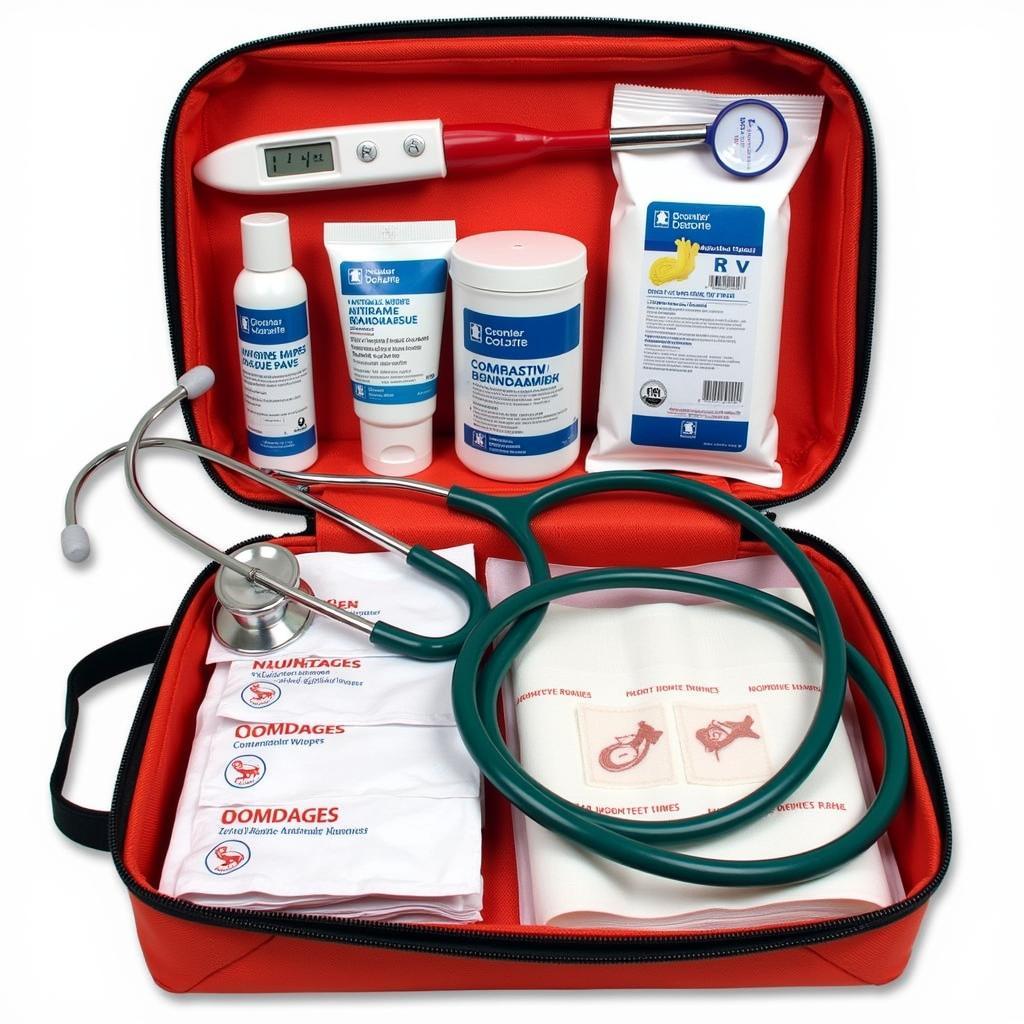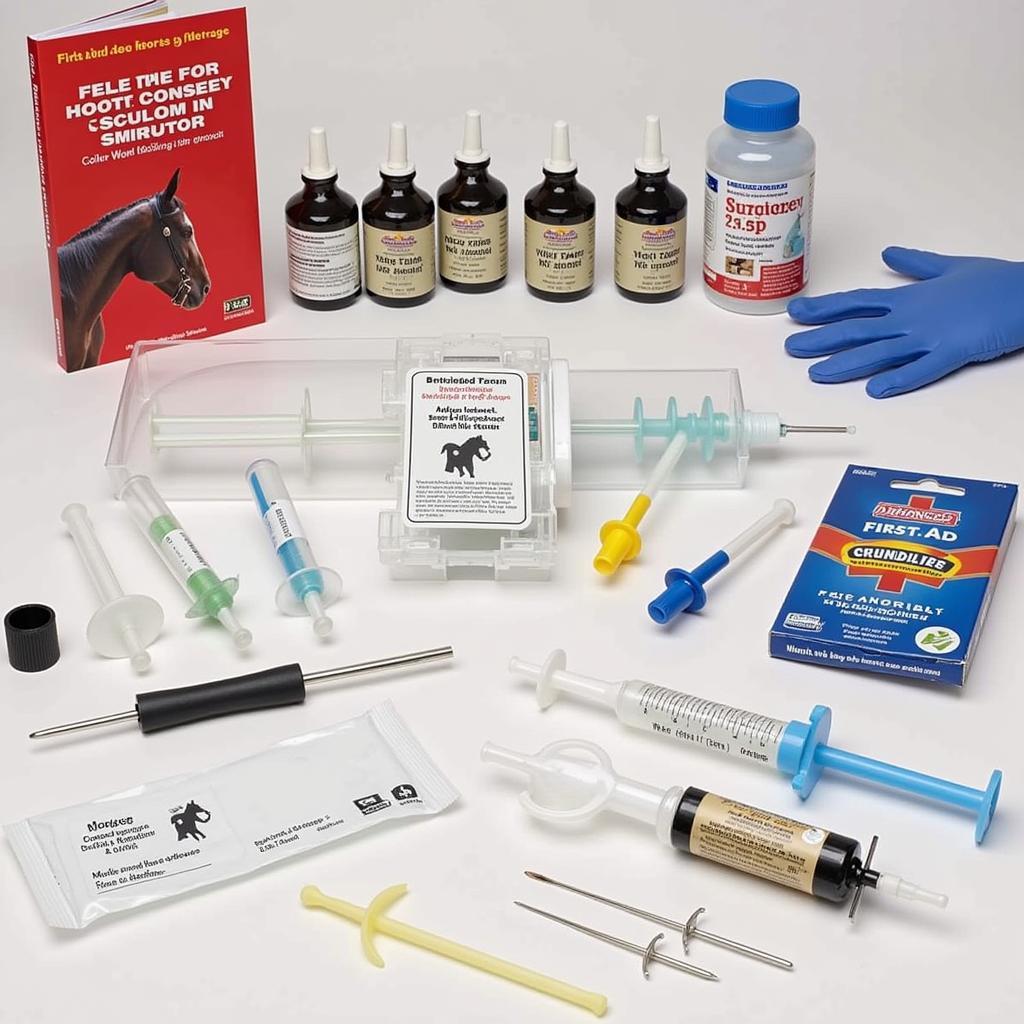A well-stocked Horse First Aid Kit is an absolute essential for any horse owner. It allows you to address minor injuries and illnesses promptly, and can even be life-saving in emergency situations until veterinary care is available. This guide provides comprehensive information on assembling a comprehensive horse first aid kit, ensuring you’re prepared for any equine health challenge.
Essential Supplies for Your Horse First Aid Kit
A comprehensive horse first aid kit should contain a variety of items to address a range of potential situations. Here’s a breakdown of the must-haves:
- Wound Care: Antiseptic solution (like chlorhexidine or povidone-iodine), sterile gauze pads, non-stick wound dressings, cotton bandages, vet wrap, and scissors. These are crucial for cleaning and protecting wounds, preventing infection, and promoting healing.
- Medications: While administering medications should always be done under the guidance of a veterinarian, having certain over-the-counter medications on hand can be helpful in emergencies. Pain relievers like Bute (phenylbutazone) – only if prescribed by your vet – can be beneficial for managing pain and inflammation. Always consult with your vet about appropriate medications and dosages for your horse.
- Tools: Thermometer (rectal), stethoscope, hoof pick, tweezers, and a flashlight are essential for assessing your horse’s condition and providing basic first aid.
- Other Essentials: Gloves (latex or nitrile), antiseptic wipes, eye wash solution, duct tape, and a small container for mixing solutions are also important additions to your kit.
Don’t forget to familiarize yourself with how to use each item. Regular checks and replenishment of supplies are essential to maintain a fully functional horse first aid kit.
What Should Be in a Basic Horse First Aid Kit?
Even a basic horse first aid kit can make a significant difference in an emergency. It should include the essentials for managing common injuries like minor cuts and abrasions. Consider including antiseptic wipes, gauze pads, cohesive bandages, and a basic wound dressing. A thermometer and stethoscope can help assess vital signs. Having a horse first aid kit checklist can be incredibly helpful to ensure you have all the necessary supplies.
 Basic Horse First Aid Kit Contents
Basic Horse First Aid Kit Contents
Dr. Emily Carter, a renowned equine veterinarian, emphasizes the importance of a basic kit: “Even a small cut can become infected if not treated properly. A basic horse first aid kit allows you to provide immediate care and minimize the risk of complications.”
Horse First Aid Kit: Advanced Care Items
For those looking to take their preparedness to the next level, an advanced horse first aid kit can be a lifesaver. In addition to the basics, consider adding items like a wound irrigation syringe, sterile saline solution, different sized needles and syringes, suture kits (for experienced individuals only), and medications for colic (as prescribed by your vet). Check our detailed horse first aid kit essentials for more information on building a comprehensive kit.
Assembling Your Horse First Aid Kit: Step-by-Step Guide
- Choose a Durable Container: Select a waterproof, easily transportable container to store your supplies.
- Organize Your Supplies: Group similar items together for quick access in emergencies.
- Label Everything Clearly: Ensure all medications and solutions are clearly labeled with their expiration dates.
- Regularly Check and Replenish: Inspect your kit periodically, replacing expired or used items.
 Advanced Horse First Aid Kit Supplies
Advanced Horse First Aid Kit Supplies
A well-equipped horse first aid kit is your first line of defense against equine health issues. Building one tailored to your needs ensures you’re prepared to handle common ailments and emergencies effectively. By having a horse 1st aid kit readily available, you can provide timely care and potentially save your horse from unnecessary suffering.
FAQs: Your Horse First Aid Kit Questions Answered
- Where should I keep my horse first aid kit? Store it in a cool, dry place, accessible both at the barn and when traveling with your horse.
- How often should I check my kit? At least every six months, to ensure medications haven’t expired and supplies are fully stocked.
- Can I use human first aid supplies on my horse? While some items can be used, it’s best to stock a dedicated horse first aid kit with appropriate equine products.
- What should I do in a serious equine emergency? Always contact your veterinarian immediately for guidance. Your first aid kit is for initial care until professional help arrives.
- Where can I find a pre-made horse first aid kit? Many tack shops and online retailers offer pre-assembled kits. However, customizing your kit ensures it meets your specific needs. Review our first aid kits for horses to choose the best option for you.
- How do I learn more about equine first aid? Consider taking an equine first aid course or consult with your veterinarian for additional guidance.
- What’s the difference between a horse first aid kit list and a checklist? A list details the items, while a checklist allows you to mark off supplies as you gather them.
Preparing a horse first aid kit is a fundamental responsibility for any horse owner. By investing in a well-stocked horse first aid kit, you demonstrate a commitment to your horse’s well-being. When a situation arises, you will be ready to provide immediate and appropriate care.
Need help? Contact us! Phone: 0772127271, Email: [email protected] Or visit us at: QGM2+WX2, Vị Trung, Vị Thuỷ, Hậu Giang, Vietnam. Our customer service team is available 24/7.